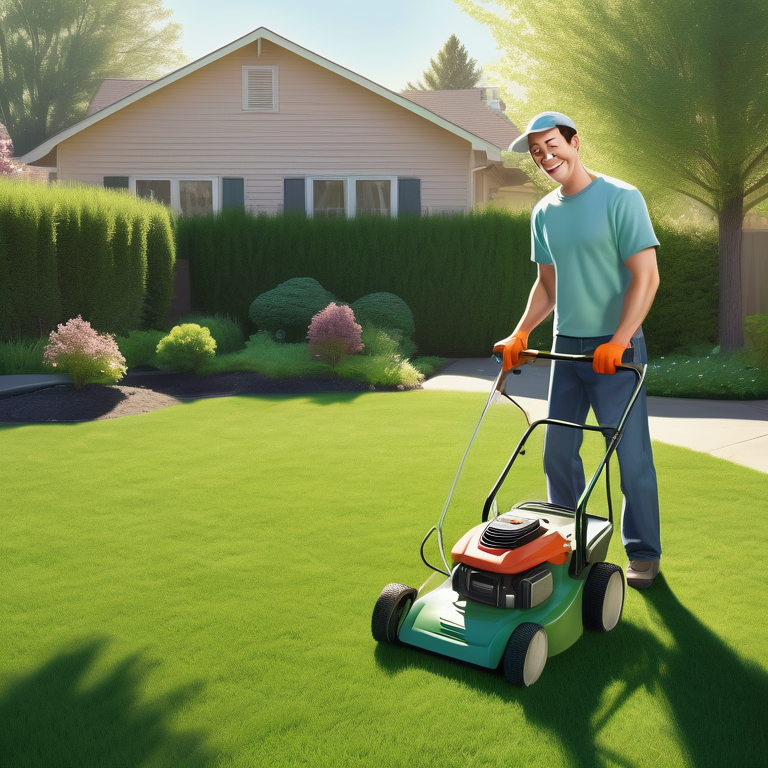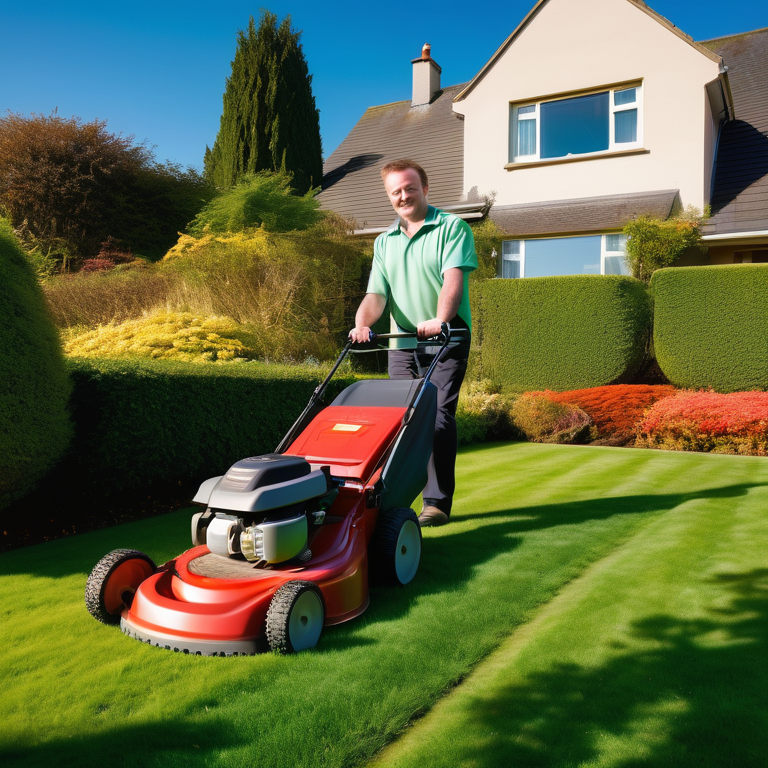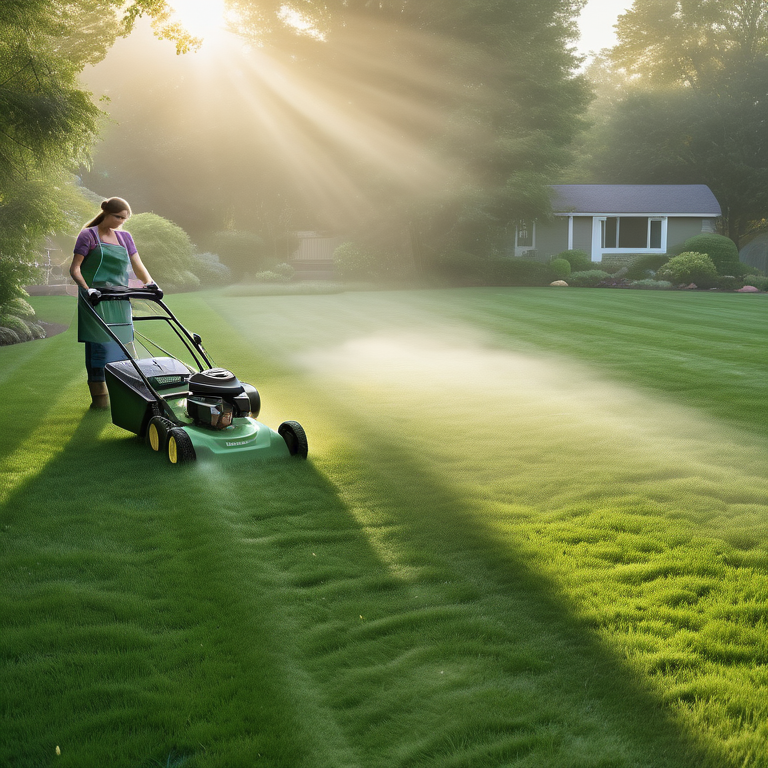Key Highlights
- The best time to start cutting grass in spring is in early Spring, typically around the last week of February or the first week of March.
- Cutting the grass in early spring helps stimulate growth, thicken the grass, and prevent weeds and moss from taking over the lawn.
- It’s important to assess the condition of the lawn after winter and take necessary steps to prepare it for its first cut of the season.
- Key indicators that it’s time to start mowing include longer grass, warmer weather, and the absence of frost.
- Before the first mow, it’s important to assess the lawn’s health, adjust the cutting height of the mower, and clear any debris from the lawn.
Introduction
Regular lawn mowing is essential for maintaining a beautiful and healthy lawn. However, knowing when to start cutting the grass in spring can be a bit challenging. Cutting the grass too early can damage the lawn, while cutting it too late can lead to overgrowth and difficulty in managing the lawn. In this expert guide, we will provide you with all the information you need to determine the right time of year to start cutting the grass for the first time in spring and the best practices for lawn care during this time.
Spring is a time of renewal and growth, and it’s no different for your lawn. As the weather starts to warm up, your grass will begin to come out of its dormancy and start growing again. This is the perfect time to give your lawn its first cut of the season with a lawnmower and set it up for healthy growth throughout the year. But when exactly should you start cutting the grass? And what steps should you take to ensure your lawn stays in top condition? We will answer all of these questions and more in this comprehensive guide, including when to start cutting the grass in spring and when to perform your last cut in autumn.
Whether you are a seasoned gardener or a beginner, this guide will provide you with expert tips and advice to help you make the right decisions for your lawn. From understanding the importance of timing to preparing your lawn for its first cut, we will cover all aspects of spring lawn care. So, let’s dive in and discover the best practices for cutting the grass in spring in Dublin and beyond.
Understanding the Right Time to Begin Lawn Care in Spring
Knowing the right time to begin lawn care in spring is crucial for achieving a healthy and vibrant lawn. While there is no specific date that applies to all regions, a general rule of thumb is to perform the first grass cut of the year in spring, around mid-March. From there on, mow the lawn at least once every week. However, it’s important to pay attention to local weather conditions and the specific needs of your lawn. By starting lawn care at the right time, in April, you can promote healthy growth, prevent weed and moss infestation, and maintain a lush and beautiful lawn throughout the year.
The Importance of Timing: Early Spring Lawn Preparation
Early spring is a critical time for lawn preparation. As the weather begins to warm up and the days get longer, your grass will start to grow more rapidly. This is the perfect time to give your lawn some attention and prepare it for the growing season ahead.
One of the main reasons why early spring lawn preparation is important is that it sets the stage for healthy and vigorous growth. By starting early, you can stimulate the grass to grow, encourage it to thicken up, and create a dense turf that is more resistant to weeds and moss. Additionally, early spring lawn care allows you to address any issues that may have emerged over the winter months, such as compacted soil or damaged grass. By taking the time to prepare your lawn in early spring, you’ll be rewarded with a beautiful and healthy lawn throughout the year. www.wicklowlandscaping.ie
Key Indicators That It’s Time to Start Mowing
Knowing when it’s time to start mowing your lawn is essential for maintaining its health and appearance. There are several key indicators that can help you determine whether it’s time to bring out the mower. Here are a few things to look out for:
- Long grass: If your grass has grown longer than usual and begins to look untidy, it’s a clear sign that it’s time for a trim.
- Warmer weather: As the weather starts to warm up in spring, the grass will begin to grow more rapidly. This is a good indication that it’s time to start mowing.
- Absence of frost: Frost can make the grass brittle and susceptible to damage if mowed. Wait for a few days after the last frost before mowing to ensure the grass is in good condition.
- Dry grass: Mowing wet grass can lead to clumping and uneven cutting. Wait for a few dry days before mowing to ensure optimal mowing conditions.
By paying attention to these key indicators, you can ensure that you mow your lawn at the right time and keep it looking its best.
Preparing Your Lawn for Its First Cut of the Season
Preparing your lawn for its first cut of the season is an important step in maintaining a healthy and vibrant lawn. By taking the time to prepare your lawn properly, you can ensure that it grows evenly, remains disease-free, and looks its best throughout the year.
Before you start mowing, it’s important to assess the health of your lawn after the winter months. Look for any signs of damage or disease, such as brown patches or thinning areas. If necessary, take steps to address these issues before mowing. Additionally, check your lawn mower to ensure that it’s in good working condition and adjust the cutting height to the appropriate level for your grass type. By preparing your lawn and equipment and clearing any rubbish that may have gathered, it’s a good idea to give your lawn its first cut of the season and set it up for a successful growing season. www.wicklowlandscaping.ie
Assessing Your Lawn’s Health After Winter
Assessing your lawn’s health after the winter months is a crucial step in preparing it for the first cut of the season. Winter can take a toll on your lawn, causing damage and leaving it in a weakened state. By assessing its condition, you can identify any issues and take appropriate action.
Start by examining the overall appearance of your lawn. Look for brown patches, thinning areas, or signs of disease. If you notice any of these issues, consider addressing them before mowing. This can include applying fertilizer, overseeding thin areas, or treating for pests or diseases.
In addition to visual inspection, gently rake the lawn to remove any debris or dead grass that may have accumulated over the winter. This will help promote airflow and prevent disease.
By assessing your lawn’s health after winter, you can take the necessary steps to ensure its successful growth and maintain its overall health and beauty. www.wicklowlandscaping.ie
Steps to Take Before the First Mow
Before the first mow of the season, there are a few important steps to take to ensure that your lawn is ready for cutting. Here are some key tasks to complete before firing up the mower:
- Adjust the cutting height: Set your lawn mower to the appropriate cutting height for your grass type. This will help ensure that you mow at the optimal length for healthy growth and appearance.
- Clear debris: Remove any debris, such as sticks or leaves, from the lawn before mowing. This will prevent the mower from getting clogged and ensure a clean cut.
- Sharpen the mower blades: Dull blades can tear the grass instead of cutting it cleanly, leading to a ragged appearance and increased risk of disease. Sharpen the blades before the first mow for a clean and precise cut.
- Check the mower’s condition: Inspect the mower for any damage or issues that may affect its performance. This includes checking the oil, fuel, and spark plug, as well as ensuring that the cutting deck is clean and in good condition.
By taking these steps before the first mow, you can ensure that your lawn receives the best care and maintains its health and beauty throughout the season. www.wicklowlandscaping.ie
Optimal Mowing Practices for Spring
Following optimal mowing practices in spring is essential for maintaining a healthy and attractive lawn. By mowing correctly, you can promote healthy growth, prevent weed and moss infestation, and keep your lawn looking its best. Here are a few key practices to keep in mind:
- Mowing height: Set your mower to the appropriate cutting height for your grass type. Mowing too short can stress the grass and make it more susceptible to disease and weeds. Aim to remove no more than one-third of the grass height in a single mow.
- Dry days: Avoid mowing wet grass as it can lead to clumping and uneven cutting. Wait for a few dry days before mowing to ensure optimal mowing conditions.
- Sharp blades: Keep your mower blades sharp to ensure a clean and precise cut. Dull blades can tear the grass, leaving it susceptible to disease and giving it a ragged appearance.
By following these optimal mowing practices, you can ensure that your lawn stays healthy and looks its best throughout the spring season.
The Best Time of Day for Cutting Grass
Choosing the best time of day to cut grass can have a significant impact on the health and appearance of your lawn. While there is some flexibility in timing, there are certain factors to consider when deciding when to mow. Late afternoon, specifically late evening, is generally considered the best time to cut grass for several reasons, including the fact that the morning dew has evaporated and the sun is higher in the sky.
- Cooler temperatures: Cutting grass in the late afternoon allows the grass to recover overnight without the stress of intense midday heat.
- Drying time: By mowing in the late afternoon, you give the grass some time to dry before evening dew sets in. Mowing wet grass can lead to clumping and uneven cutting.
- Plant recovery: Cutting grass in the late afternoon allows the plants to recover and heal overnight, reducing the risk of disease or stress.
While late afternoon is generally recommended, it’s important to consider your specific lawn conditions and adjust the timing accordingly. By choosing the best time of day to cut grass, you can ensure optimal lawn health and appearance.
How Often Should You Mow in Spring?
How often you should mow your lawn in spring depends on several factors, including the growth rate of your grass, the weather conditions, and your desired lawn appearance. Here are some general guidelines to help you determine the mowing regime for your lawn:
- Growth rate: Different grass types have different growth rates. Some may require more frequent mowing, while others may grow more slowly. Observe the growth rate of your grass and adjust your mowing schedule accordingly.
- Weather conditions: Warmer temperatures and adequate moisture can promote rapid grass growth. If the weather is favorable, you may need to mow more frequently to maintain the desired lawn height.
- Desired appearance: Some homeowners prefer a perfectly manicured lawn and may choose to mow more often to achieve that look. Others may prefer a more natural or wild look and can mow less frequently.
As a general rule, it’s recommended to never remove more than one-third of the grass height in a single mow. This helps prevent stress to the grass and promotes healthier growth. By adjusting your mowing frequency based on these factors, such as mowing occasionally on a high cut setting in areas with full sun and good moisture levels, you can maintain a well-maintained and attractive lawn throughout the spring season. www.wicklowlandscaping.ie
Choosing the Right Equipment for Spring Lawn Care
Choosing the right equipment for spring lawn care is essential for achieving the best results. From lawn mowers to mower blades, having the right tools can make the task easier and more efficient. Here are a few considerations when selecting equipment for your lawn care:
- Lawn mower: Choose a mower that is suitable for your lawn size, terrain, and personal preferences. Options include manual reel mowers, electric mowers, and gas-powered mowers.
- Mower blade: Ensure that your mower blade is sharp and in good condition. A dull blade can tear the grass instead of cutting it cleanly, leading to a ragged appearance and increased risk of disease.
By selecting the right equipment for your spring lawn care, you can ensure that the task is easier, more efficient, and produces the best results for your lawn. www.wicklowlandscaping.ie
Selecting the Best Mower for Your Lawn Type
Selecting the best mower for your lawn type is crucial for achieving optimal results. Different mowers are designed to handle different types of lawns and terrain. Here are a few factors to consider when choosing a mower:
- Lawn size: Consider the size of your lawn. For smaller lawns, a manual reel mower or electric mower may be sufficient. For larger lawns, a gas-powered mower with a wider cutting deck may be more efficient.
- Terrain: Take into account the terrain of your lawn. If you have slopes or uneven ground, a self-propelled mower may be easier to maneuver.
- Grass type: Different grass types have different maintenance requirements. Consider the type of grass in your lawn and choose a mower that is suited to its specific needs.
By selecting the best mower for your lawn type, you can ensure that the task of mowing is easier, more efficient, and produces the best results for your specific lawn.
Maintenance Tips for Your Mowing Equipment
Proper maintenance of your mowing equipment is essential for ensuring optimal performance and longevity. Here are some maintenance tips to keep your mowing equipment in good condition:
- Sharpen the mower blade: A sharp blade cuts the grass cleanly, resulting in a neater appearance and reduced risk of disease. Sharpen the blade regularly to maintain its cutting effectiveness.
- Clean the mower: Remove any debris, grass clippings, or dirt from the mower after each use. This helps prevent clogging and ensures that the mower operates at its best.
- Check the oil and fuel: Regularly check the oil and fuel levels in your mower to ensure smooth operation. Follow the manufacturer’s recommendations for oil and fuel changes.
- Store properly: When not in use, store your mowing equipment in a clean and dry area. This helps prevent rust and other damage.
By following these maintenance tips, you can extend the life of your mowing equipment and ensure that it continues to perform at its best.
Common Mistakes to Avoid When Mowing in Spring
Mowing the lawn in spring requires careful attention to detail and proper techniques. Avoiding common mistakes can help ensure that your lawn remains healthy and beautiful throughout the season. Here are a few common mistakes to avoid when mowing in spring:
- Mowing too soon: Cutting the grass too early in spring can damage the lawn, especially if the ground is still wet or frosty. Wait for the right conditions before mowing.
- Mowing when the grass is wet: Mowing wet grass can lead to clumping and uneven cutting. Wait for the grass to dry before mowing.
- Cutting the grass too short: Mowing the grass too short can stress the plants and make them more susceptible to disease and weed infestation. Avoid cutting more than one-third of the grass height at a time.
By avoiding these common mistakes, you can ensure that your lawn stays healthy and looks its best throughout the spring season. www.wicklowlandscaping.ie
Mowing Too Soon: Understanding the Risks
Mowing too soon in spring can pose several risks to your lawn. It’s important to understand these risks and wait for the right conditions before mowing. Here are some potential risks of mowing too soon:
- Damaging wet grass: Mowing wet grass can lead to clumping and uneven cutting. This can create an unsightly appearance and make it more difficult for the grass to recover.
- Compacting wet soil: Mowing wet grass on wet soil can lead to soil compaction. This can prevent air and water from reaching the grass roots, hindering growth and overall lawn health.
- Spreading diseases: Mowing wet grass can spread diseases, especially if the mower blades come into contact with infected grass. This can lead to further damage and the spread of diseases throughout the lawn.
By waiting for the right conditions and avoiding mowing too soon, you can mitigate these risks and ensure the health and appearance of your lawn. www.wicklowlandscaping.ie
Avoiding Damage to Wet or Frosty Grass
Avoiding damage to wet or frosty grass is essential for maintaining a healthy and attractive lawn. Mowing under these conditions can lead to numerous problems and should be avoided. Here are some tips for avoiding damage to wet or frosty grass:
- Wait for dry conditions: Wait for a few dry days before mowing to ensure that the grass is dry and the soil is not overly saturated. This will prevent clumping and help achieve a clean and even cut.
- Avoid mowing frosty grass: Mowing frosty grass can damage the blades and lead to uneven cutting. Wait for the frost to melt and the grass to dry before mowing.
- Be cautious with dew: Mowing early in the morning while the grass is still wet with dew can result in clumping and uneven cutting. If possible, wait for the grass to dry before mowing.
By following these tips and avoiding mowing wet or frosty grass, you can protect your lawn and maintain its health and appearance.
Advantages of Early Lawn Care in Spring
Engaging in early lawn care in spring offers numerous advantages for your lawn’s health and appearance. By giving your lawn some attention and care early on, you can set it up for success throughout the growing season. Here are some key advantages of early lawn care:
- Encouraging healthy root development: Early lawn care promotes healthy root growth, which is essential for the overall health and resilience of the grass.
- Establishing a dense turf: By starting early, you can encourage the grass to thicken up and create a dense turf that is more resistant to weeds and moss.
- Preventing weed and moss infestation: Early lawn care helps prevent weed and moss infestation by encouraging healthy grass growth and providing a competitive advantage.
By taking advantage of early lawn care, you can enjoy a beautiful and healthy lawn that will be the envy of your neighbors. www.wicklowlandscaping.ie
Encouraging Healthy Growth and Density
Encouraging healthy growth and density in your lawn is a key goal of early spring lawn care. By implementing the right practices, you can promote the growth of a lush and vibrant lawn. Here are some tips for encouraging healthy growth and density:
- Provide adequate water: Water your lawn deeply and infrequently to encourage the growth of deep roots. This helps the grass withstand drought and other stresses.
- Fertilize appropriately: Apply a slow-release fertilizer in early spring to provide the necessary nutrients for healthy growth. Follow the manufacturer’s instructions for application rates and timing.
- Mow at the correct height: Set your mower at the appropriate cutting height for your grass type to encourage dense growth. Avoid cutting the grass too short, as this can weaken the plants and leave them susceptible to disease and weed infestation.
By following these tips, you can encourage healthy growth and density in your lawn, resulting in a beautiful and vibrant landscape. www.wicklowlandscaping.ie
Preventing Weeds and Diseases Early On
Preventing weeds and diseases early in the spring is crucial for maintaining a healthy and attractive lawn. By implementing preventive measures, you can reduce the risk of weed and disease infestation. Here are some tips for preventing weeds and diseases early on:
- Maintain proper mowing height: Mowing at the correct height helps promote dense turf that can outcompete weeds. Avoid cutting the grass too short, as this can weaken the plants and leave them more susceptible to weed invasion.
- Implement proper watering and fertilization practices: Proper watering and fertilization can help strengthen the grass and make it more resistant to weeds and diseases. Water deeply and infrequently and apply a slow-release fertilizer according to the manufacturer’s instructions.
- Monitor and address issues early: Regularly inspect your lawn for signs of weeds or diseases. If you notice any issues, take appropriate action promptly to prevent further spread.
By focusing on prevention and early intervention, you can maintain a lush and healthy lawn that is free from weeds and diseases. www.wicklowlandscaping.ie
Conclusion
In conclusion, starting your spring lawn care at the right time sets the stage for a healthy and vibrant lawn. By understanding the indicators signaling the beginning of mowing season and following optimal mowing practices, you can promote lush growth and deter weeds. Remember to assess your lawn’s health post-winter and choose appropriate mowing equipment for best results. Avoid common mistakes like mowing too early or on wet grass to prevent damage. Early lawn care not only enhances your lawn’s appearance but also strengthens its resilience against potential issues, ensuring a beautiful outdoor space for enjoyment throughout the season. www.wicklowlandscaping.ie
Frequently Asked Questions
What is the earliest I can safely mow my lawn in spring?
The earliest you can safely mow your lawn in spring depends on local weather conditions and the specific needs of your lawn. As a general rule, aim to start mowing in early spring, around the last week of February or the first week of March. However, it’s important to pay attention to frost, soil moisture, and grass growth before mowing.
How do I know if my lawn is ready to be mowed?
You can determine if your lawn is ready to be mowed by looking for key indicators such as longer grass, warmer weather, and the absence of frost. Additionally, pay attention to local conditions and the specific needs of your grass type. Aim to start mowing in early spring, but adjust based on these factors.
Can mowing too early harm my lawn?
Mowing too early in spring can potentially harm your lawn. Cutting the grass too soon, especially when the ground is wet or frosty, can damage the grass and make it more susceptible to disease. It’s important to wait for the right conditions before mowing to prevent harm to your lawn.
Tips for transitioning from spring to summer lawn care
Transitioning from spring to summer lawn care requires a few adjustments to ensure continued health and appearance. Some tips for a smooth transition include adjusting watering and fertilization practices, monitoring for pests and diseases, and adjusting mowing frequency based on grass growth.










